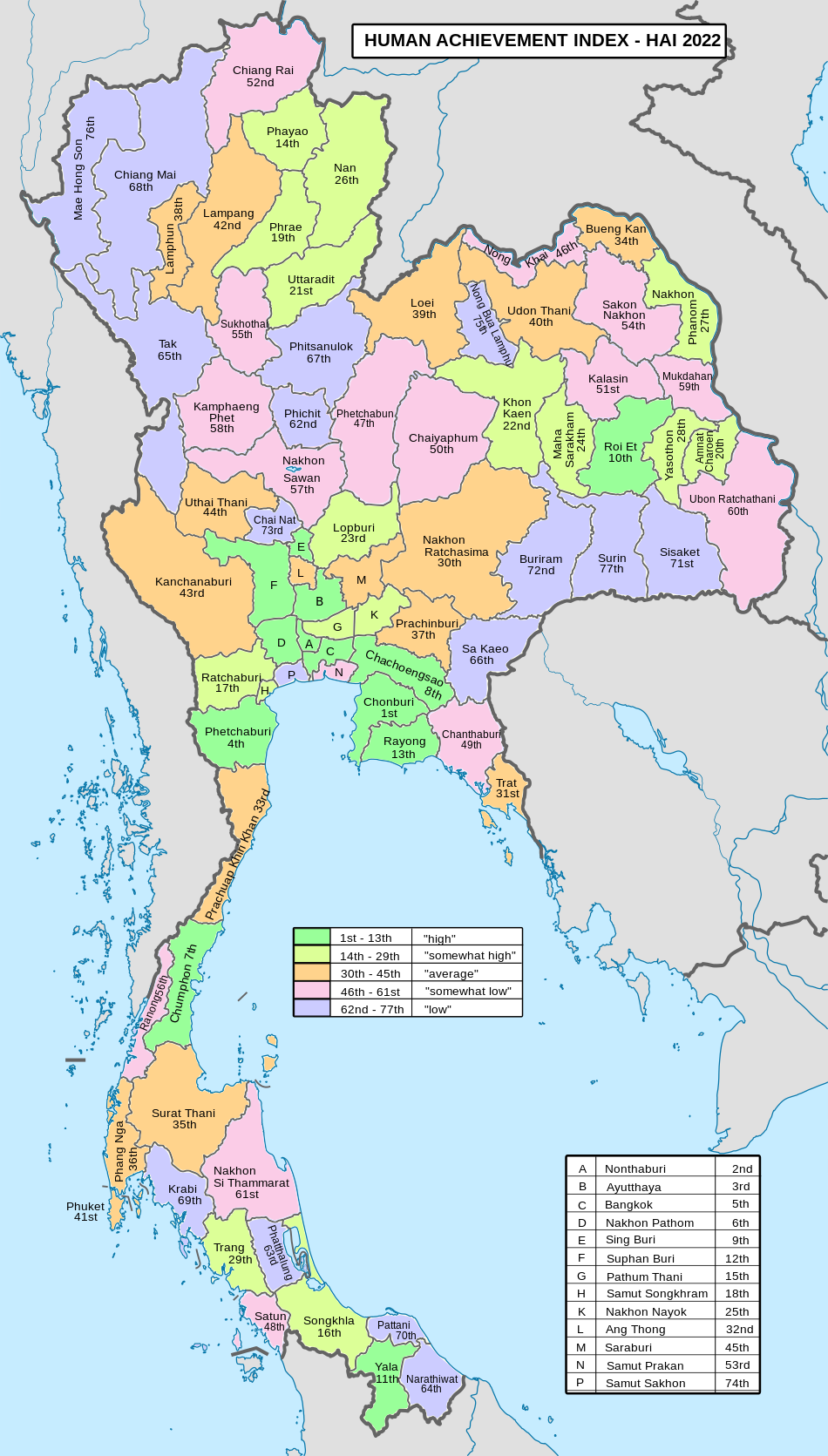Ratchaburi province
This article is written like a travel guide. (August 2017) |
Ratchaburi
ราชบุรี | |
|---|---|
 Old Ratchaburi Provincial Hall, now Ratchaburi National Museum | |
| Nickname(s): Mueang Ong (Thai:เมืองโอ่ง) (lit. City of Jars) | |
| Motto(s): คนสวยโพธาราม คนงามบ้านโป่ง เมืองโอ่งมังกร วัดขนอนหนังใหญ่ ตื่นใจถ้ำงาม ตลาดน้ำดำเนินฯ เพลินค้างคาวร้อยล้าน ย่านยี่สกปลาดี ("Beautiful women of Photharam. Exquisite women of Ban Pong. City of dragon jars. Nang Yai of Wat Khanon. Sensational caves. Damnoen (Saduak) floating market. Amazing millions of bats. Delicious fish from the Yi Sok area.") | |
 Map of Thailand highlighting Ratchaburi province | |
| Country | Thailand |
| Capital | Ratchaburi |
| Government | |
| • Governor | Ronnapop Luangpairote (since Oct. 2020) |
| Area [1] | |
| • Total | 5,196 km2 (2,006 sq mi) |
| • Rank | Ranked 42nd |
| Population (2018)[2] | |
| • Total | 873,518 |
| • Rank | Ranked 27th |
| • Density | 168/km2 (440/sq mi) |
| • Rank | Ranked 21st |
| Human Achievement Index [3] | |
| • HAI (2022) | 0.6577 "low" Ranked 17th |
| GDP [4] | |
| • Total | baht 173 billion (US$6.1 billion) (2019) |
| Time zone | UTC+7 (ICT) |
| Postal code | 70xxx |
| Calling code | 032 |
| ISO 3166 code | TH-70 |
| Website | www.ratchaburi.go.th |

Ratchaburi province (Thai: จังหวัดราชบุรี, pronounced [t͡ɕāŋ.wàt râːt.t͡ɕʰā.bū.rīː]) or Rat Buri (pronounced [râːt bū.rīː]) is one of Thailand's seventy-six provinces (changwat) lies in Western Thailand. Neighbouring provinces are (from north clockwise) Kanchanaburi, Nakhon Pathom, Samut Sakhon, Samut Songkhram and Phetchaburi. In the west it borders the Tanintharyi Region of Myanmar.
Ratchaburi is 80 kilometres (50 mi) west of Bangkok and borders Myanmar to the west with the Tenasserim Hills as a natural border.[5] The Mae Klong flows through the centre of Ratchaburi town.
Geography
Ratchaburi province is a medium-sized province with an area of about 5,196 square kilometres (2,006 sq mi). The eastern part of the province contains the flat river plains of the Mae Klong, crisscrossed by many khlongs. The most famous tourist spot in this area is the Damnoen Saduak Floating Market. The west of the province is more mountainous, and includes the Tenasserim Hills. As the mountains are made mostly of limestone, there are several caves containing stalactites. Some caves are inhabited by large colonies of bats, and it is an impressive sight when they swarm out in the evening to feed. Other caves like the Khao Bin are accessible for visitors.
The main river of the western part is the Phachi River. On the left bank of the Phachi is the Chaloem Phrakiat Thai Prachan National Park, 329 km2 (127 sq mi),[6]: 124 along with eight other national parks, make up region 3 (Ban Pong) of Thailand's protected areas. There is one wildlife sanctuary, along with two other wildlife sanctuaries, make up region 3 (Ban Pong) of Thailand's protected areas. Mae Nam Phachi Wildlife Sanctuary, 489 km2 (189 sq mi).[7]: 4
The area of Ratchaburi province is divided into three parts. First, the border in the west which is shared with Myanmar and is about 60 kilometres (37 mi) long. The second contains the Tenasserim mountains and forests with an elevation of about 200–300 meters. The central area of the province is rich in wetlands due to river flow. Ratchaburi has important natural resources in its forest of which it covers an area of 1,711 km2 (661 sq mi) or 33 percent of provincial area.[8] Moreover, it has minerals such as tin, tantalum, feldspar, quartz, limestone, and marlstone.[9]
History
The history of the city of Ratchaburi dates back to the Dvaravati period, when it was an important city of the Mon Kingdom. Of the city of Khu Bua nearby only ruins remains. According to legend it dates back to the mythical Suvannabhumi Kingdom predating Dvaravati.
"Ratchaburi" means 'the land of the king'.[10] Ratchaburi dates back to ancient times and was important during the Dvaravati period. The city of Ratchburi is on the banks of the Mae Klong River and was a town of the Suvarnabhumi Kingdom.
From the evidence of archaeological sites and many antiquities, believed that people have settled in this area since the Middle Stone Age, as well as discovering an ancient city in the Dvaravati period at Mueang Ratchaburi district. King Rama I used to take a position of Royal Yokkrabat of Ratchaburi in the late Ayutthaya period.
In the late Ayutthaya period and early Rattanakosin period, there is historical evidence that Ratchaburi is an important frontier city, It is a battlefield for many ages. Especially during the reign of King Rama I has brought troops to set up the Burmese battle in Ratchaburi area many times, the most important one was the Burmese–Siamese War (1785–1786).
Later in 1817, In the reign of King Rama II has ordered to build a new city wall on the left bank of the Mae Klong River until the present. In the reign of King Rama V in 1894, has changed the government and included the city that are close together to set up as counties and included the city of Ratchaburi, Kanchanaburi, Samut Songkhram, Phetchaburi, Pran Buri and Prachuap Khiri Khan to set up as Ratchaburi county.
Demographics
Hill tribes, mostly Karen living near the Myanmar border, make up about one percent of the population. Some Mon, Lawa, Lao, Chinese and Khmer minorities live in the province.[11]
Ratchaburi is 98.3 percent Buddhist.[12]: Table 4
Symbols
The provincial seal shows the royal sword above the royal sandals on a phan, as the name Ratchaburi means 'city of the king'. The name derives from the fact that King Rama I was born here. The provincial slogan is "Beautiful women of Photharam. Exquisite women of Ban Pong. City of dragon jars. Nang Yai of Wat Khanon. Sensational caves. Damnoen (Saduak) floating market. Amazing millions of bats. Delicious fish from the Yi Sok area." The provincial flower is the Pink Shower Tree (Cassia bakeriana), and the provincial tree is Wrightia pubescens.[13] Jullien's golden carp (Probarbus jullieni) is a provincial fish, same as neighbouring province Kanchanaburi, that has good taste and flourished in the Mae Klong River in the past, but is now critically endangered.[14]
Transportation
Rail
The main railway station in Ratchaburi is Ratchaburi railway station.
Health
Ratchaburi Hospital is the main hospital of the province.
Administrative divisions

Provincial government
The province is divided into 10 districts (amphoes).[15] The districts are further subdivided into 104 sub-districts (tambons) and 935 villages (mubans).
Local government
As of 26 November 2019 there are:[16] one Ratchaburi Provincial Administration Organisation (ongkan borihan suan changwat) and 34 municipal (thesaban) areas in the province. Ratchaburi, Ban Pong, Tha Pha and Photharam have town (thesaban mueang) status. Further 30 subdistrict municipalities (thesaban tambon). The non-municipal areas are administered by 77 Subdistrict Administrative Organisations - SAO (ongkan borihan suan tambon).[2]
Human achievement index 2022
Since 2003, United Nations Development Programme (UNDP) in Thailand has tracked progress on human development at sub-national level using the Human achievement index (HAI), a composite index covering all the eight key areas of human development. National Economic and Social Development Board (NESDB) has taken over this task since 2017.[3]
| Rank | Classification |
| 1 - 13 | "high" |
| 14 - 29 | "somewhat high" |
| 30 - 45 | "average" |
| 46 - 61 | "somewhat low" |
| 62 - 77 | "low" |
| Map with provinces and HAI 2022 rankings |

|
Gallery
-
Khao Bin bat cave
-
Wat Khlong, the largest ruin of Khu Bua
-
Bus terminal by Mae Klong, Ban Pong
-
Muban Chombueng Rajabhat University, a branch of Rajabhat University in Chom Bueng
-
The Scenery Vintage Farm, resort of Suan Phueng
-
Sign of Nong Pladuk Junction Railway Station, the junction station of southern railway line and the starting point of the Death railway
-
Chet Samian Railway Station, Photharam
-
Nang Yai Shadow Puppet Museum in Wat Khanon, Photharam
-
Chaloem Phrakiat Rama 9 Road, Ban Pong
-
Corridor in Ratchaburi National Museum
References
- ^ Advancing Human Development through the ASEAN Community, Thailand Human Development Report 2014, table 0:Basic Data (PDF) (Report). United Nations Development Programme (UNDP) Thailand. pp. 134–135. ISBN 978-974-680-368-7. Retrieved 17 January 2016, Data has been supplied by Land Development Department, Ministry of Agriculture and Cooperatives, at Wayback Machine.
{{cite report}}: CS1 maint: postscript (link)[dead link] - ^ a b "รายงานสถิติจำนวนประชากรและบ้านประจำปี พ.ศ.2561" [Statistics, population and house statistics for the year 2018]. Registration Office Department of the Interior, Ministry of the Interior (in Thai). 31 December 2018. Retrieved 20 June 2019.
- ^ a b "ข้อมูลสถิติดัชนีความก้าวหน้าของคน ปี 2565 (PDF)" [Human Achievement Index Databook year 2022 (PDF)]. Office of the National Economic and Social Development Council (NESDC) (in Thai). Retrieved 12 March 2024, page 64
{{cite web}}: CS1 maint: postscript (link) - ^ "Gross Regional and Provincial Product, 2019 Edition". <>. Office of the National Economic and Social Development Council (NESDC). July 2019. ISSN 1686-0799. Retrieved 22 January 2020.
- ^ "Ratchaburi". Tourist Authority of Thailand (TAT). Archived from the original on 2015-05-20. Retrieved 28 May 2015.
- ^ "ข้อมูลพื้นที่อุทยานแห่งชาติ ที่ประกาศในราชกิจจานุบกษา 133 แห่ง" [National Park Area Information published in the 133 Government Gazettes]. Department of National Parks, Wildlife and Plant Conservation (in Thai). December 2020. Retrieved 1 November 2022.
- ^ "ตาราง 5 พื้นที่เขตรักษาพันธุ์สัตว์ป่า พ.ศ. 2562" [Table 5 Wildlife Sanctuary Areas in 2019] (PDF). Department of National Parks, Wildlife Sanctuaries and Plant Conservation (in Thai). 2019. Retrieved 1 November 2022.
- ^ "ตารางที่ 2 พี้นที่ป่าไม้ แยกรายจังหวัด พ.ศ.2562" [Table 2 Forest area Separate province year 2019]. Royal Forest Department (in Thai). 2019. Retrieved 6 April 2021, information, Forest statistics Year 2019
{{cite web}}: CS1 maint: postscript (link) - ^ "Ratchaburi has important "natural resources"". Retrieved 4 Nov 2013.
- ^ Choomjit, Y. (1994). History of Ratchaburi. Bangkok: Odienstore.
- ^ Svasti, Pichaya (14 September 2017). "Time-travelling along the Mae Klong River". Bangkok Post. Retrieved 16 September 2017.
- ^ "Population by religion, region and area, 2015" (PDF). National Statistical Office (NSO). Retrieved 2017-10-12.
- ^ "Welcome to Ratchaburi Province, Thailand". encyclopediathai.org. Archived from the original on 2015-09-24. Retrieved 28 May 2015.
- ^ "สัญลักษณ์ประจำจังหวัด" [Provincial symbols]. Canghwadrachburiffff (in Thai). Retrieved 2020-04-23.
- ^ Ratchaburi is divided into "10 districts", Retrieved 4 Nov 2013, from http://www.encyclopediathai.org/sunthai/center/ratburi/ratburi.htm Archived 2012-12-15 at the Wayback Machine
- ^ "Number of local government organizations by province". dla.go.th. Department of Local Administration (DLA). 26 November 2019. Retrieved 10 December 2019.
50 Ratchaburi: 1 PAO, 4 Town mun., 30 Subdistrict mun., 77 SAO.
External links
 Ratchaburi travel guide from Wikivoyage
Ratchaburi travel guide from Wikivoyage- Ratchaburi Thai Only
- English website of province Archived May 6, 2008, at the Wayback Machine
- Ratchaburi Samanachan Archived March 31, 2012, at the Wayback Machine
13°31′44″N 99°48′52″E / 13.52889°N 99.81444°E / 13.52889; 99.81444







.jpg/440px-ริมน้ำแม่กลองท่ารถ_บ้านโป่ง_-_panoramio_(1).jpg)
.jpg/440px-มหาวิทยาลัยราชภัฏหมู่บ้านจอมบึง1_-_panoramio_(1).jpg)



_1.jpg/440px-Ratchaburi_Shadow_Puppet_Museum_(Wat_Khanon)_1.jpg)

.jpg/440px-Ratchaburi_Musuem_-_2017-04-16_(035).jpg)